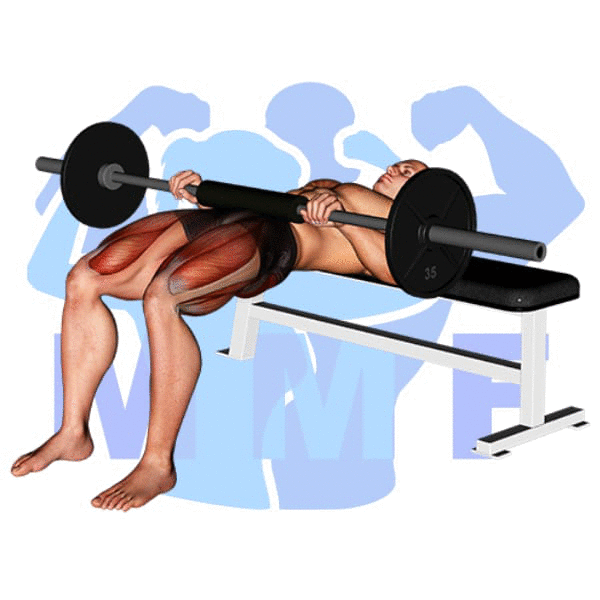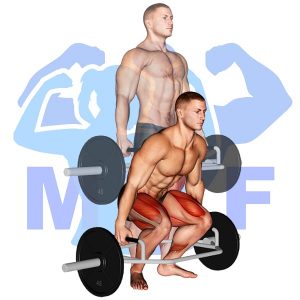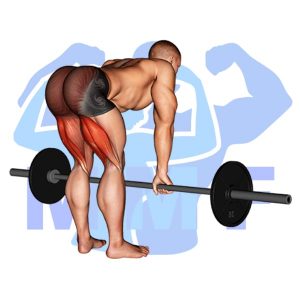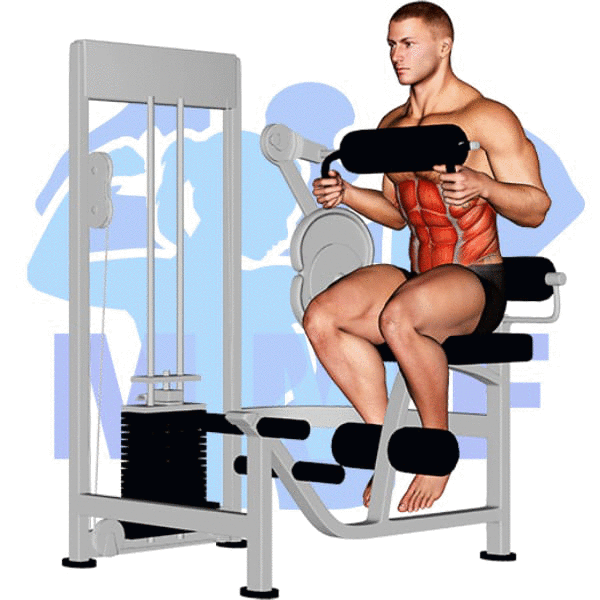If you’re looking to build your glutes, you’ve likely stumbled across the barbell hip thrust exercise. But if you’re struggling to get the most out of this movement or experiencing discomfort, you’re not alone. Many individuals find it challenging to perfect their form or experience pain when performing a barbell hip thrust. Sympathy aside, this common issue can be frustrating and even make some individuals give up on the exercise entirely. But don’t worry, with some simple tips and tricks, you can troubleshoot any problems and start reaping the benefits of the barbell hip thrust. In this blog post, we’ll cover everything from proper form to common mistakes to help you perfect your technique and take your glutes to the next level.
Barbell Hip Thrust Summary
- Primary Muscles: Gluteus Maximus
- Secondary Muscles: Quadriceps
- Equipment: Barbell and Bench
- Mechanics Type: Isolation
- Force: Push
- Utility: Auxiliary

Barbell Hip Thrust Instructions
- To setup, sit on the floor with the long side of the bench behind your back.
- Roll the barbell back and center over your hips. Positioning your upper back on the edge of the bench. Place feet on floor approximately shoulder width with knees bent. Grasp bar to each side.
- Raise the bar by extending your hips until straight
- Then, lower the bar and repeat for your desired reps.
Video Tutorial
Barbell Hip Thrust Muscles
Target (Agonist)
Synergists
Dynamic Stabilizers
Stabilizers
Antagonist Stabilizers

Benefits of Barbell Hip Thrust
The Barbell Hip Thrust is an excellent exercise to strengthen and build the gluteus maximus muscle. This exercise is great for improving power, strength, and stability in the lower body. The barbell hip thrust helps to develop and maintain strong glutes while also working on balance and coordination. This exercise can be used as part of a strength training or fitness routine to help improve overall health and performance. By regularly performing the Barbell Hip Thrust, you can see an increase in glute strength and stability which can lead to improved athletic performance, better posture, and a reduction in risk of injury.
Tips for Performing Barbell Hip Thrust
These tips are essential for anyone looking to make the most out of their Barbell Hip Thrust workouts. Before implementing these strategies, it’s important to make sure you have proper form and technique. Proper form and technique will ensure that you get the most out of each exercise and minimize your risk of injury. With that in mind, let’s look at some tips to help you get the most out of your Barbell Hip Thrust workout.
- Build Your Form Before You Increase The Resistance. getting an accurate form will certainly aid in preventing injuries and faltering early. Quality Form will certainly enable you to build muscle tissue faster.
- Complete Power Sets. Is where you do a set of a couple of completely different lifts back to back. Generally, there are two major options to do power sets, first is to concentrate on a single muscle. The other is to focus on different muscle groups.
- Always Maintain A Weightlifting Journal. You ought to have a record of all weights, sets, and repetitions. When you are great you will in addition write down your rest times. There are a whole lot of high-quality apps to use a log, or you could simply make use of a little notebook.
- Keep Your Core Tight. For most exercises, you will need to help support your back by flexing your abs to strengthen your inner pressure all-around your spinal column.
Benefits and Tips Video
Frequent Mistakes To Avoid
It’s important to make sure you’re doing the Barbell Hip Thrust correctly in order to get the most out of it. To help you avoid any common mistakes, we’ve compiled a list of the most frequent errors people make when doing this exercise. Read on to find out what you should be avoiding!
- Try Not To employ bad technique. Improper form can be a fast way to experience a trauma.
- Don’t Make It To Easy. The primary way to get gains is to challenge yourself.
- Don’t use To Little or Too Much Resistance. Not enough, and you will not be sufficiently employing your agonist (target) muscles, more than the right amount, and you’ll most likely need to cheat. Ensure you concentrate on your form.
Find More Barbell Exercises Here
Variations and Complementary Exercises
If you are looking for variations, complementary, or alternative exercises for the Barbell Hip Thrust, there are a few exercises that work similar muscles. These can help to keep your workout routine fresh, increase difficulty, and prevent overtraining. Below is a list of some of these exercises.
Barbell Deadlift

The barbell deadlift is a great exercise for building strength and size in the lower body. It is a compound exercise that works the quads, hamstrings, glutes, and core. It is also a great exercise for building overall functional strength. The barbell hip thrust is a great alternative or complementary exercise to the barbell deadlift. This exercise focuses more on the glutes and hamstrings, which can help to improve the development of the lower body and help to prevent lower back injuries. The hip thrust also allows for heavier loads to be used compared to the deadlift, which can lead to greater strength gains. Both exercises are beneficial in developing overall lower body strength and size.
Band Stiff Leg Deadlift

The Band Stiff Leg Deadlift is an excellent alternative or complementary exercise to the Barbell Hip Thrust. This exercise works on the same muscles as the Barbell Hip Thrust, but with a slightly different emphasis. The Band Stiff Leg Deadlift works to strengthen the hamstrings, glutes and lower back, while also challenging the core for stability. It is an effective exercise for building strength, power and balance in the hips, as well as for improving posture and mobility. The Band Stiff Leg Deadlift is an excellent exercise for athletes looking to improve their performance and those just looking to get stronger and more toned.
Trap Bar Deadlift

The Trap Bar Deadlift is a great complementary or alternative exercise to the Barbell Hip Thrust. It is a compound exercise that engages the entire body, especially the posterior chain, while also helping to build core strength. The Trap Bar Deadlift is a great way to challenge the muscles that are used in the Barbell Hip Thrust without having to use a barbell. It allows for more range of motion and can be done with lighter weights, making it an ideal exercise for novice lifters. Additionally, the Trap Bar Deadlift does not require as much lower back stabilization as the Barbell Hip Thrust and can help reduce back strain for those who experience it with the Barbell Hip Thrust.
Check Out These Top Barbell Exercises
Barbell Dimmel Deadlift

The Barbell Dimmel Deadlift is a great complementary or alternative exercise for the Barbell Hip Thrust. This exercise is performed by standing with feet hip-width apart, holding a barbell with both hands in front of the body. The arms are then kept straight and the back is kept flat as the barbell is pulled up towards the chest. This exercise works the same muscles as the Barbell Hip Thrust, while also activating the posterior chain and helping to build strength in the lower back and glutes. Additionally, this exercise increases stability and balance, allowing for a more effective hip thrusting motion.
Barbell Snatch Deadlift

The Barbell Snatch Deadlift is a complementary exercise to the Barbell Hip Thrust, as it helps to increase strength and power in the glutes and hamstrings. This exercise works by lifting a barbell from the ground to waist height, while keeping the core tight and engaging the glutes and hamstrings. This exercise can be done in place of the Barbell Hip Thrust to help increase power and strength in the lower body, while also working on stabilizing the core. It is a great alternative to the Barbell Hip Thrust as it helps to target similar muscles, but also adds an extra challenge for those looking for a more intense workout.
Barbell Straight Leg Deadlift

The Barbell Straight Leg Deadlift is a popular exercise for targeting the glutes and hamstrings. It is an alternative or complementary exercise to the Barbell Hip Thrust, as it allows you to work the same muscles while also engaging the core and lower back. The difference between the two exercises is that the Barbell Straight Leg Deadlift requires you to keep your legs straight throughout the movement, while the Barbell Hip Thrust requires you to bend your legs and thrust your hips up. Both exercises are excellent for strengthening your glutes and hamstrings, and can be incorporated into any lower body routine.
Find More Glutes Exercises Here
Opposing Complementary Exercises
To further enhance your glute-strengthening workout, it is important to include exercises that target the opposing muscle groups. By targeting opposing muscles, you will be able to increase your strength and prevent any imbalances. Here are some exercises that complement the exercise Barbell Hip Thrust:
Barbell Zercher Squat

The Barbell Zercher Squat is an intense lower body exercise that works the quads, glutes, and hamstrings. It is complementary to the Barbell Hip Thrust as it works the opposite muscle group. The Zercher Squat puts more emphasis on the quads, whereas the Hip Thrust focuses on the glutes and hamstrings. Both exercises are effective for developing strength, power and muscle definition in the lower body. They can be combined for a comprehensive lower body workout that will improve overall performance.
Bulgarian Half Squat With Band

The Bulgarian Half Squat With Band is a great exercise for targeting the quads, glutes, and hamstrings. It is the perfect complement to the Barbell Hip Thrust, as it works the opposing muscle group. The Bulgarian Half Squat With Band is performed by attaching a band to a secure object and looping it around the ankles. You then perform a half squat with your feet slightly wider than shoulder-width apart, making sure to keep your back straight and drive through your heels. This exercise is great for increasing strength and power in the lower body muscles and can be used as part of an overall lower body strengthening program.
Dumbbell Half Squat

The Dumbbell Half Squat is an excellent complimentary exercise to the Barbell Hip Thrust. It works the opposite muscle group, targeting the quadriceps, hamstrings, glutes, and core muscles. This exercise helps to create balance and stability in the body and is great for strengthening the lower body muscles. By performing this exercise after the Barbell Hip Thrust, you will be able to engage the opposing muscle group, allowing for a complete lower body workout.
Transform Your Glutes with Barbell Hip Thrusts
If you’re looking to shape and tone your glutes, the barbell hip thrust is an effective exercise to add to your routine. By targeting the muscles in your butt, hips, and thighs, you can transform your body and increase your overall strength and fitness. To perform the barbell hip thrust, you’ll need a barbell and a bench or other elevated surface. This exercise can be challenging, but with proper form and technique, you’ll see results in no time. Incorporate barbell hip thrusts into your workouts and you’ll be well on your way to achieving the toned, lifted butt you’ve always wanted.
References: Wikipedia | ExRx.net | PubMed.gov | Comprehensive List of Glutes Barbell Exercises




